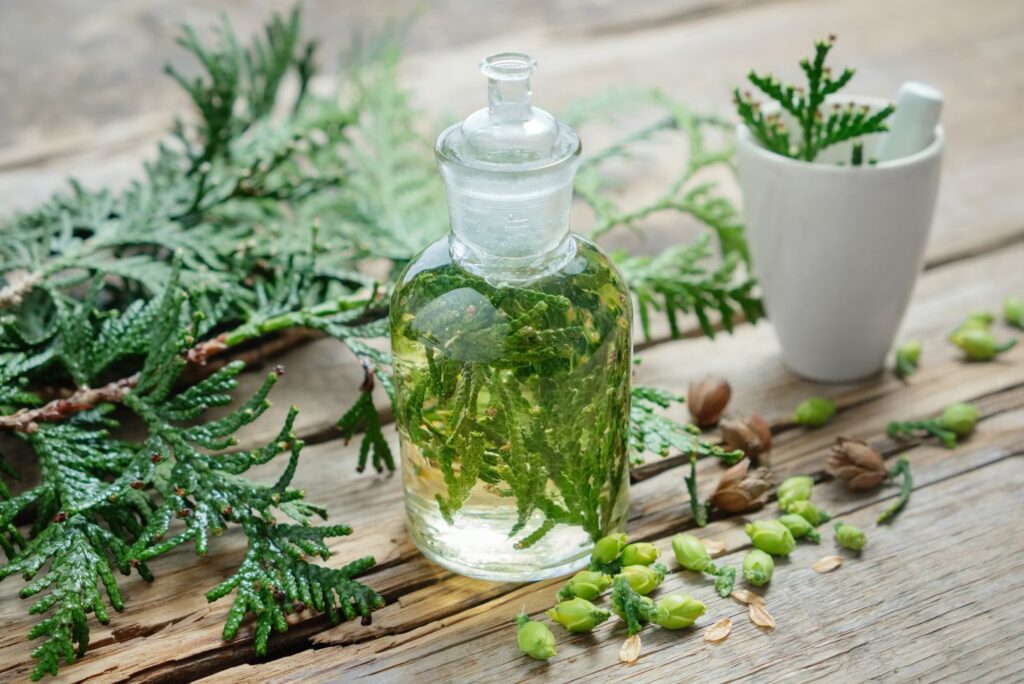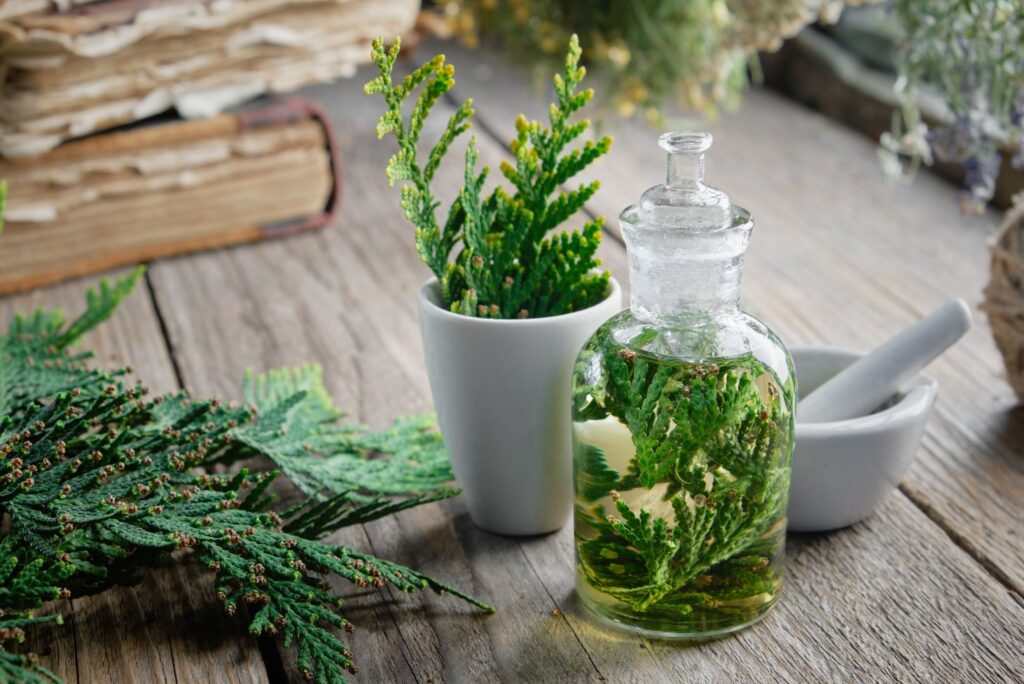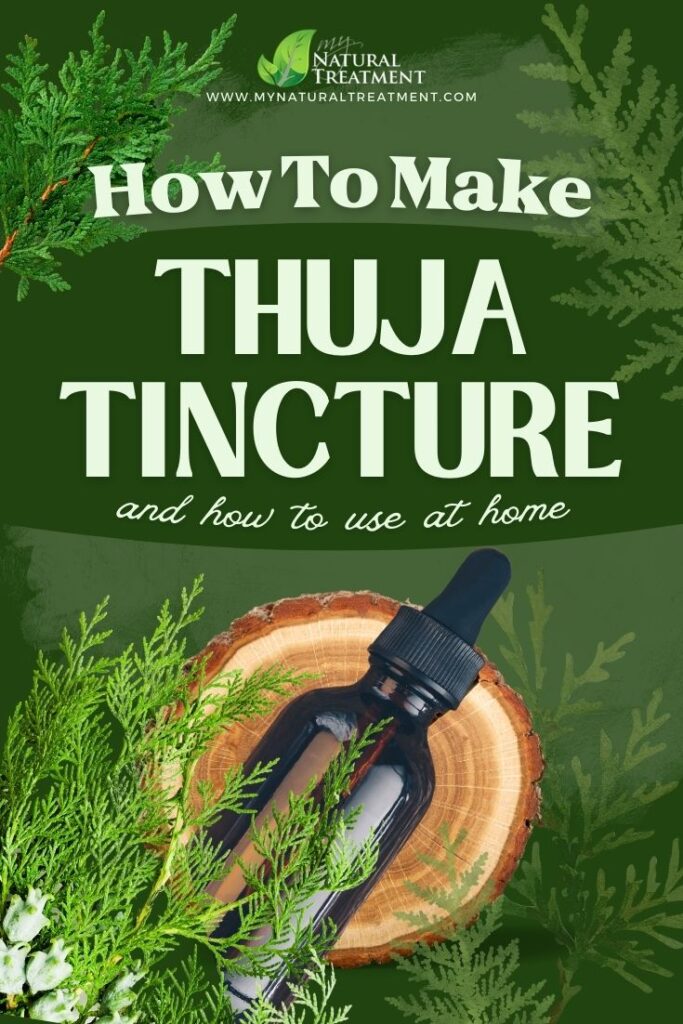Want to learn how to make thuja tincture following an ancient thuja tincture recipe from Eastern Europe? Continue reading this article and find out.
Did you know that thuja, one of the most popular ornamental bushes, is actually a medicine on its own? Indeed, Dakota and Sioux tribe red skins used thuja as a treatment for benign tumors, cancer, dementia, organ dysfunction, respiratory tract infections, and many other diseases. Last decade medical research about the health benefits of thuja has confirmed what Native Indian healers already knew.
Native American healers consider thuja “the tree of life” and believe it has divine powers.

In This Article You Will Find:
How to Harvest Thuja Leaves
Thuja leaves are ideally harvested in the winter when the essential oils secreted are at their maximum concentration. Use a pair of scissors to cut the young thuja leaves off. This operation does not affect the vitality of the bush, but on the contrary, it helps to restore it. The young thuja leaves are used fresh to make medicine, to preserve their active principles.
Thuja Types
The best-known species of thuja are Thuja occidentalis, originally from the eastern coasts of North America, and Thuja orientalis, originally from China and Japan. They are very similar in appearance, having practically the same therapeutic properties. Both species, cultivated or semi-spontaneous, grow in gardens, in parks, but also on the edges of forests or next to industrial facilities. Thuja is one of the most pollution-resistant bushes and a great air purifier.

Thuja Tincture Recipe
This thuja tincture is a very potent alcoholic extract prepared from freshly harvested thuja leaves. Here is how to make thuja tincture at home. Put 200 grams of finely chopped green thuja leaves in a jar and pour a liter of 60-degree food alcohol on top. Seal the jar and leave it for 10 days in a warm spot to macerate. Shake the jar daily. Strain the maceration and pour the resulting thuja tincture into sealed amber bottles.
Important! Thuja tincture has a fairly high toxicity (due to thujone, the main essential oil in thuja), which is why it should not be administered internally, except with consent and under the supervision of a herbalist specialist. Thus, the therapeutic applications presented below are only informative, for an internal treatment with thuja you should consult a medical doctor.

Thuja Tincture Uses
Thuja extract has an exceptional ability to gently stimulate the endocrine, being an effective adjuvant in the case of conditions such as hypothyroidism. In combination with echinacea tincture, it significantly increases the body’s natural defense capacity, being a real help in all infectious, bacterial, or viral conditions that affect the respiratory tract. Thuja tincture dissolved in water gargles has an antimicrobial effect, being also recommended in pharyngitis, tracheitis, pharyngotonsillitis, etc.
This tincture has strong anti-inflammatory and anti-infectious effects at the genito-urinary level, being recommended in prostatitis, but also in hemorrhagic or recurrent cystitis. Used against breast nodules, uterine fibroids, ovarian cysts, and polyps of all kinds, as well as against tumor formations that appear on the skin.
9 Ways to Use Thuja Tincture at Home
- Benign Tumors (breast nodules, uterine fibroids, ovarian cysts, polyps of all kinds, skin tumor formations, adjuvant in cancerous tumors, especially genital and anal cancers) – one teaspoon (5 ml) of thuja tincture three times a day over the course of 3 weeks, with a week off. Topically, apply compresses with thuja tincture to the affected area once every two days. Leave on for two hours, remove and leave the skin to air-dry. Additionally, apply thuja salve applied twice a day to the affected areas.
- Flu, Bronchitis, Recurrent Respiratory Infections – one teaspoonful of equal amounts of thuja tincture and echinacea tincture, 3 times a day – is especially recommended for those who have taken or frequently take synthetic antibiotics or cortisone derivatives, drugs that are scientifically proven to weaken natural immunity.
- Urinary Incontinence – one teaspoon (5 ml) of thuja tincture diluted in half a cup of water, four times a day, in 2-week courses, with a 10-day break. Additionally, take thuja leaves sitz baths in the evening.
- Ovarian Insufficiency – 3 teaspoons (morning, lunch, and evening) over the course of 28 days.
- Rhinitis & Sinusitis – put 3-4 tablespoons of thuja tincture in half a liter of hot water in a pot and use for steam inhalation for 5-10 minutes. Then keep your face and head covered for 15 minutes, and do not go out in the cold for the next four hours.
- Tonsillitis (including purulent and gangrenous tonsillitis) – gargle with two teaspoons of thuja tincture dissolved in a little water.
- Warts (skin and genital warts) – put a cotton pad well soaked in thuja tincture on the wart, then cover it with a patch to fix it in place. Leave it on for 24 hours, change it for a new one, and continue for 14 consecutive days. If you can’t stand the sting of the alcohol, anoint the affected areas with thuja salve instead, two or three times a day.
- Rheumatism – apply warm thuja tincture compresses, once every other day. Anoint the affected area twice a day with thuja salve.
- Corns & Calluses – apply a compress with thuja tincture, wrap cling foil around it and keep it on overnight. This is also an effective remedy for fingernail and toenail fungus.
Thuja Tincture Safety and Contraindications
There is a fairly well-rooted belief that thuja is a poisonous plant. The statement is only partially true. Indeed, thuja contains an active principle, which gives it its specific scent – thujone – which, when administered in large doses, can cause serious digestive, metabolic, and even nervous disorders. Thuja tincture also contains thujone, but in a very small amount: about 3 mg per 100 ml. As of December 2, 2002, the Scientific Committee of the European Commission issued a statement in which it is mentioned that up to 5 mg per day of thujone can be safely consumed without risk. Therefore, the risks of using thuja tincture are almost non-existent when not overdosing.
Read Also: Thuja Salve Recipe and How to Use
“Thuja tincture makes any abnormal skin formation disappear over time and is among the best-known remedies for treating benign tumors in general”. David Hoffman
This thuja tincture recipe is a simple yet effective medicine from the Danube Valley, in Europe. Please share this article so more people learn to make thuja tincture at home and the health benefits of thuja tincture. Stay healthy, naturally!
Share on Pinterest ❤️

